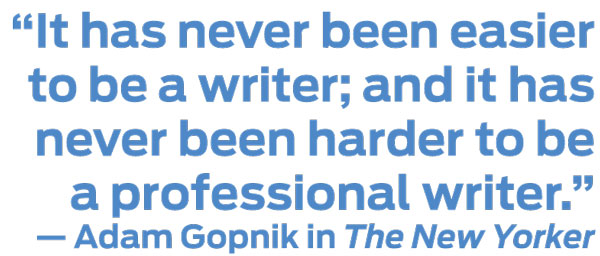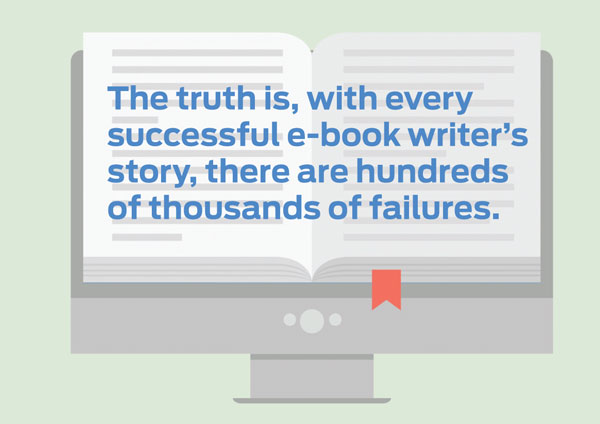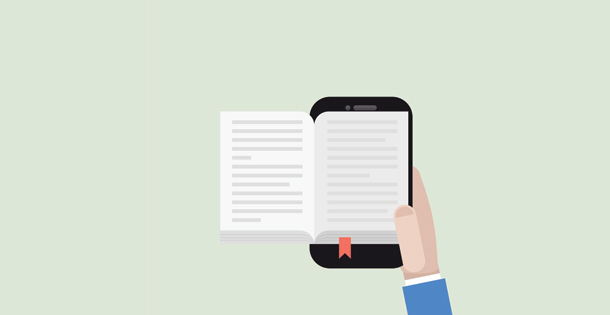Six months after Maurice Sendak died in May 2012, The Believer published an interview British journalist Emma Brockes had done with him. She asked him his opinion of e-books. “I hate them,” Sendak responded. “It’s like making believe there’s another kind of sex. There isn’t another kind of sex. … Even as a kid, my sister, who was the eldest, brought books home for me, and I think I spent more time sniffing and touching them than reading. I just remember the joy of the book, the beauty of the binding.” [Read the related article “A War on Writers?” by Steven Slon from the Jan/Feb 2015 issue.]
I know the feeling. I too grew up holding, fondling, and smelling books. When I got older I began collecting them. I’ve spent hundreds, probably thousands, of hours hunting down books of writers I’ve gotten to know. When I began writing books of my own, there was such a thrill to see them in print. I will never forget walking past the Madison Avenue Bookstore in Manhattan the week my Conversations with Capote was published in the winter of 1985. It was my first book. And there it was. It was, to say the least, a very special, very personal moment.
My books — my own, and all the others I’ve collected — mean a great deal to me. But I no longer hold the opinion Mr. Sendak did. I don’t hate e-books. I can’t, because my last seven books have been — I hate to admit — e-books.
When Ann Patchett, best-selling author of Bel Canto and State of Wonder, and the owner of an independent bookstore in Nashville, Tennessee, was asked her opinion of e-books, she said, “I care that you read, not how you read.”
I care too. I care very much. The 11 books I am currently reading weigh 19.5 pounds; in my Kindle they weigh zero — that alone makes a good case for e-reading.
“The recent contractions and consolidations in the publishing business — layoffs, dwindling sales and advances, mergers of houses once thought unassailable — have left a widespread sense of unease about the durability of books,” Giles Harvey wrote in a recent New Yorker article about why failed novelists turn to writing memoirs about their failures. “Reading in bed with his girlfriend, novelist Benjamin Anastas wonders if the rise of e-books ‘will help keep writing alive and well into the digitized future, or if my problems are an early warning that my profession is about to go extinct.’”
I don’t think books will go extinct. More precisely, it’s become a changing art. According to the book research firm Bowker, self-publishing now accounts for more than 458,564 books annually, with Amazon leading the way. E-books cannot be ignored. The new problem is how to separate the good from the bad and the ugly.
In the April 2013 Wired, Evan Hughes wrote, “After centuries in which books and the process of publishing them barely changed, the digital revolution has thrown the entire business up for grabs. It’s a transformation that began with the rise of Amazon as an online bookseller and accelerated with the resulting decline of the physical bookstore. But with the shift to e-books — which now represent upwards of 20 percent of big publishers’ revenue, up from 1 percent in 2008 — every aspect of the existing framework is now open to debate: how much books will cost, how long they’ll be. … The only certainty is that the venerable book business, a settled landscape for so long, is now open territory for anyone to claim.”
Adam Gopnik, writing in The New Yorker, expressed a similar sentiment. “Thanks to the Internet, the disproportion between writerly supply and demand, always tricky, has tipped: Anyone can write, and everyone does, and beginners are expected to be the last pure philanthropists, giving it all away for the naches. It has never been easier to be a writer; and it has never been harder to be a professional writer.”
It has always been hard to be a professional writer. And yes, it’s a lot harder today. When I started writing books, I received an advance from a publisher that allowed me enough time to write the book. It was never a great deal of money — I got $50,000 for the first book, and $215,000 was the most I ever got, but that book (The Hustons) took me three years to write. Thankfully I was able to supplement my income by writing for magazines, until that world began to shrink as well. So the challenge is to continue being a professional writer — i.e., a writer who makes a living from his writing — in an e-book, self-publishing world. That was the quandary for most of the writers I knew. The only way to find out was to jump in. If I wanted to write what I wanted to write — novels, satire, poetry, memoirs — I would have to test the waters by sticking my own feet in them. I made an investment in myself. And a deal with Amazon. Would it turn out to be a deal with the devil? Or with my savior?
I’m not alone. Name writers like Stephen King, Joyce Carol Oates, and David Mamet have all put out e-book originals. But, as Bruce Miller, president of Miller Trade Book Marketing warned, “Celebrity authors may have great luck self-publishing, but most authors are not famous.”
Amazon has added a new twist to this market by hiring an editor, David Blum, who carefully selects Amazon Singles, original works of 5,000 to 30,000 words of both nonfiction and fiction. He gets more than 1,000 submissions a month and has published 345 Singles in the first two years of the program. Approximately one-third of these have sold at least 10,000 copies, at an average of $2 per Single. As the writer gets 70 percent of this, it’s understandable why so many are trying to make the cut.
But the truth is, with every successful e-book writer’s story, there are hundreds of thousands of failures. “There are so many stories out there about people who have made it big self-publishing,” literary publicist Julia Drake told Publishers Weekly Select, a magazine devoted to self-publishing, “and there’s not enough out there about the 99 percent of the authors who’ve self-published a book and it disappears.” The only reality each writer faces is his own.
My first step was to spend $350 to digitize the four books of mine whose rights had been returned to me: Conversations with Capote, The Hustons, Conversations with Michener, Above the Line, and Conversations with Brando. Then I found out about Amazon’s White Glove Program, a program for established writers. If invited in, Amazon will take care of the business of digitizing your books and will work with you to get them ready for self-publication, pending your approval. I was invited to join that program. And then they told me about their Select program, where I would be “allowed” to offer any of my books for free to their readers for up to five days over three months. Why would I do that? I wondered. To raise my profile, I was told. The higher one’s profile, the better chance of gaining new readers. Freebies were designed to create word-of-mouth sales. And since I had more than one book, if a reader took one of my books for free, they might be encouraged to buy the others. Besides the four previously published books, I had seven others I was working on. My Amazon contact thought it would be a smart idea to release them all at the same time. Instead of putting out one book and waiting, I could put out all 11 books, so when someone went to my book page they could see all of them at once. But I was still some distance away from publishing. Before I could digitize them I needed my trusty copy editor to go over each and every paragraph. Once she was done, I needed to place the photos I wanted to include, to get permission to use illustrations and quotes, and to get each book cover designed. Once everything was in order, I gave the books to Amazon. When they said they were ready, I went over each of them and found problems that had to be fixed. That back and forth took a few more months. When it came time to click publish and see these books go public, I next had to think about how to market them. Because so many books go out into the electronic world each day, I was really just getting started. And this was the worst part of the process, because it meant letting all the people I knew, through email, Facebook, LinkedIn, and Twitter, that these books were now available.
This was now my welcome to the real world of social networking. The world where all your friends, and “friends,” and former students send congratulations and encouragement and then go on with their busy lives. In other words, ignoring your pleas to buy your books. That’s when you begin to see the genius in Amazon’s free books idea. If they won’t purchase, then you can give them a taste, select one of the books, and nudge them to buy the others. So, I put up Capote first, and lo and behold, 2,000 people took it the first day. When sales of the other books remained meager, I offered them Brando for free. One thousand took that one. When no one was buying either of the novels, I put one up one month, the other the next. Four hundred people took them. Yoga? No! Shmoga!, my satire on yoga? I could barely give it away. How do I know how many people are buying, borrowing, or taking them for free? Because I can go to my reports on Amazon and check the month-to-date unit sales. Whereas before I had to wait six months to find out how any of my books were selling, now it is instant.
The first month, I earned over $600. The second, around $400. The third, under $200. It’s not exactly what I was selling in print. The Hustons had a 50,000 print run and supposedly sold 80 percent of those; I don’t have the figures of all the other books, but I do know that each of them sold at least in the four or five figures.
Stephen Marche, in Esquire, has pooh-poohed writers who whine about the terrible state of publishing today. He points out that “for writers starting out, there are more options, more means of access to the marketplace, than ever before.” And he quotes two pollsters (Gallup and Pew) who claim that the number of books the average American reads per year is 17. He says we’re in “the golden age for writers and writing.”
I agree that there are more options for writers today, but what Marche neglects to address is how many of these options allow a writer to actually earn a living from his writing. He points to how J.K. Rowling is richer than the queen of England and that Tom Wolfe got $7 million for his last novel, but there will always be writers who hit the literary lottery. It’s all the others in the game that Marche dismisses by saying “Everyone seems to understand and accept this golden age except the writers themselves.” Well, yes, the writers in the trenches. They don’t quite understand and accept. As for the average American reading 17 books a year? You’ve got to be kidding me. I know a lot of educated people. Very few of them read 17 books a year. Most people I know just read occasionally and watch a lot of TV. They can reference Mad Men, Game of Thrones, Seinfeld episodes, and Downton Abbey. But ask them what they thought of The Gravedigger’s Daughter or The Emperor of All Maladies and see if their eyes cross.
“It does seem a bit high,” said Joyce Carol Oates when I asked her what she thought about it. Oates is the only writer I know who can write 17 books a year. “Maybe these are self-help books and cookbooks,” she mulled.
Having taught gifted English majors at UCLA for 10 years, I’m pretty convinced that even they didn’t read much more than what they were assigned. It may be far easier for all of them, and for anyone else, to self-publish these days, but getting people to actually read these things? That’s a whole other story.
Become a Saturday Evening Post member and enjoy unlimited access. Subscribe now



